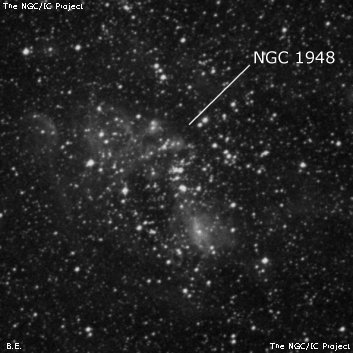
James Dunlop probably discovered NGC 1948 = D 237 on 6 Nov 1826 with his 9" reflector and described a "a rather large faint nebula, 3' or 4' diameter, of an irregular round figure; no central concentration. His position is about 6' SW of NGC 1948, certainly within his usual errors, and his size estimate (3' or 4') is reasonable. Another possible assignment is NGC 1945 = D 237, situated a similar distance south-southwest of his position. But NGC 1945 is much smaller (roughly 30"), so this seems much less likely to me, though Glen Cozens suggests the possible equivalence with D 237.
JH independently discovered NGC 1948 = h2856 on 3 Jan 1837 and described "a rich, discrete cluster, class VII. Not much compressed to the middle; 10' diameter, stars of 13th mag." His position is accurate. Herschel didn't credit Dunlop as the discoverer and neither did Dreyer in the NGC.
300/350mm - 13.1" (2/20/04 - Costa Rica): at 105x this is a fairly large star group in the LMC. Over a dozen mag 12-13 stars are resolved in a triangular group, ~6' diameter, over unresolved background haze or possibly nebulosity. NGC 1978, a bright "blue globular", lies 18' E.
600/800mm - 24" (4/11/08 - Magellan Observatory, Australia): this is a large, well-resolved star cloud (stellar association LH 52) and emission nebula. The richest section is ~8' diameter, with a roughly diamond shape. Approximately 60 stars were resolved at 260x over haze. A fairly large, nebulous knot (LMC-N48B) was visible on the southwest side, ~1.2' diameter, and it responded well to a UHC filter. A couple of other very small knots or clumps of stars were visible at the center (LMC-N48A and N48C). Two parallel streams of stars and unresolved haze (roughly 3' apart), oriented SW to NE, extended southwest from NGC 1948 through NGC 1946 to NGC 1945. The western string was brighter, consisting of a number of mag 12-14 stars along with an unresolved glow (stars and/or nebulosity) extending at least 10'. These objects are located on the west side of the huge LMC-4 Superbubble.
LMC-N49, located 11' NNE, is the brightest LMC supernova remnant and it harbors a powerful pulsar. At 260x unfiltered, it appeared as a bright "U" shape just under 1' in diameter with the center of the "U" at the east end (base oriented SW-NE) and open on the west side. The interior is much dimmer than the rim. The brightest spot is right at the east end, though the rim is much brighter and better defined along the entire base. The northern bar of the "U" side is fainter and oriented NW-SE with some haze spreading into the interior. The southern bar is brighter and narrower. A UHC filter increased the contrast and there were hints of more complex filamentary structure. Located 3.7' ENE of mag 9.0 HD 36257. Open cluster S-L 463, which appears as a very small knot attached to a star, is located 2.4' NE.
Notes by Steve Gottlieb